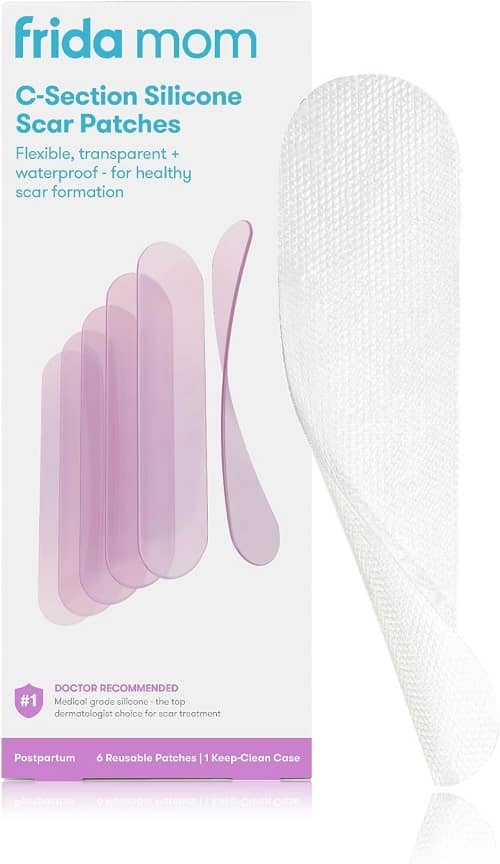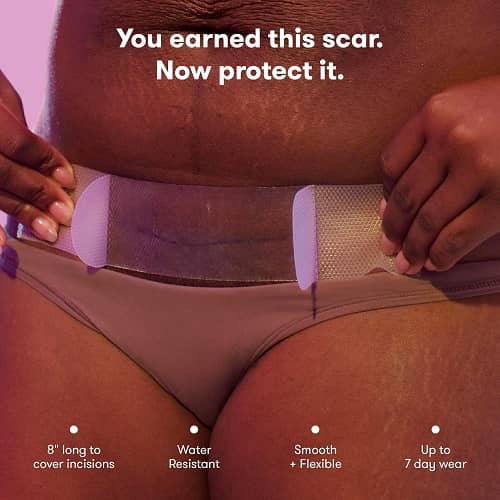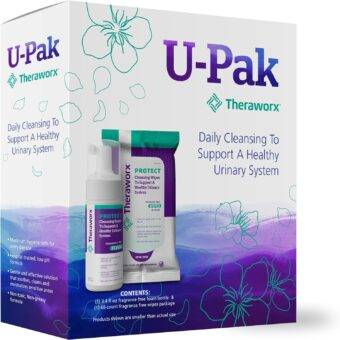Postpartum scars are common for new mothers. Selecting suitable silicone scar patches can speed up the healing process. In this guide, we’ll walk you through the key factors. You should consider them when picking the best silicone patches. They cut through postpartum scars, reviving your skin’s natural appearance.

Table of Contents
- I. Understanding Postpartum Scars and Silicone Patches
- II. Factors to Consider When Choosing Silicone Patches
- III. Tips for Selecting the Right Silicone Patch for Your Scar
- IV. How to Test the Effectiveness of Silicone Patches
- V. Common Mistakes to Avoid When Using Silicone Patches
- VI. How to Use Silicone Patches for Optimal Results
- The Benefits of Silicone Patches in Reducing Postpartum Keloid Scars
- FAQ
Key Takeaways:
-
Find the type of scar. See if you have hypertrophic, keloid, or atrophic scars. Then, choose the right silicone patches for effective treatment.
-
Consider the size and shape of the scars. Select patches made of silicone that completely envelop the scar. They should be easy to trim to fit odd shapes.
-
Check the quality and effectiveness. Look for silicone patches that are tough, reusable, and have proven results. They reduce the appearance of scars for postpartum treatment.
I. Understanding Postpartum Scars and Silicone Patches
1.1. What are postpartum scars?
There’s a good chance that after giving birth, you may notice some scarring on your body. Postpartum scars are common. They usually result from the cuts made during a C-section. Or from tears during vaginal delivery. These scars can range from small marks to more noticeable raised or pigmented areas on your skin.
Postpartum scars can sometimes be itchy or uncomfortable as they heal, and they may take time to fade. Treat scars with care to promote healing and reduce visible signs.
1.2. How Silicone Patches Work for Scar Treatment

Silicone patches are a popular choice for scar treatment. They use them on postpartum scars. Silicone patches work by creating a barrier over the scar. This barrier hydrates the skin and boosts collagen. This process helps to flatten and lighten the scar over time, making it less noticeable.
Apply silicone patches to clean, dry skin for simple use. They are comfortable to wear. You can wear them under clothing. This allows you to go about your day while the patch works its magic on your scar.
II. Factors to Consider When Choosing Silicone Patches

Choosing the best silicone patches for postpartum scars requires careful thought. You must consider many factors. Here are some key aspects to keep in mind as you make your decision.
2.1. Material Quality and Safety
-
Manufacturers may manufacture some silicone patches with lower-quality materials. These materials trigger skin irritation or allergic reactions. Look for patches made with medical-grade silicone. This is important for safety and efficacy.
-
Assume high-quality silicone patches are hypoallergenic and latex-free. Clinicians conducted rigorous trials to assess their scar-healing potential. This will give you peace of mind as you use them on your postpartum scars.
2.2. Adhesive Strength and Comfort
-
Patches with strong adhesive qualities will stay in place for a longer period of time. This will promote better scar healing over time. Choose patches with a strong hold. They should be easy to remove without causing pain or skin irritation.
-
Patches should also be thin and flexible. They should mold to your body’s contours. This allows underwear to stay hidden beneath clothes at all times.
2.3. Patch Size and Shape Options
When selecting silicone patches, check the size and shape options. This will ensure you can select patches that best fit your postpartum scars. Choose patches that you can cut to the desired shape for a customized fit and that are versatile.
2.4. Brand Reputation and Customer Reviews

Consider different brands of silicone patches. Look at their market reputation and customer reviews. Choose a brand with a proven track record in scar treatment. Check customer feedback to gauge satisfaction and results.
III. Tips for Selecting the Right Silicone Patch for Your Scar
Many different silicone patches are available on the market for postpartum scar treatment. To ensure you choose the best one for your needs, consider the following tips:
-
Assessing Your Scar Type and Size
-
Considering your skin type and sensitivity.
-
Evaluating the Patch’s Water Resistance and Durability
3.1. Assessing Your Scar Type and Size

The type and size of a scar are crucial. They determine how well silicone patches work. For raised or hypertrophic scars, choose thicker patches. They provide more pressure to flatten the scar. If you have a larger scar, choose a patch that can cover the entire area for the greatest results. Knowing the specific traits of your scar will help you pick the best silicone patch.
3.2. Considering your skin type and sensitivity.
Your skin type and sensitivity level are important factors to consider. You should take them into account when selecting a silicone scar treatment patch. If you have sensitive skin, look for patches that are hypoallergenic and gentle. This will help prevent any adverse reactions. A silicone patch features a soft, breathable material. It is suitable for all skin types. It ensures comfort and adherence throughout the treatment process.
IV. How to Test the Effectiveness of Silicone Patches
4.1. Understanding the Science Behind Silicone Patch Therapy
Not all silicone patches are equal for treating postpartum scars. Silicone patches work by creating a barrier over the scar. This barrier helps to hydrate and flatten the skin. This process can help improve the appearance of scars over time.
Many people know that silicone patches are effective in treating scars.
They do this by regulating collagen production. They also soften the scar tissue, reduce redness and itching.
4.2. Measuring Scar Improvement and Results

You may be considering using silicone patches for postpartum scars. You may wonder how to tell if they work. Some silicone patches have measurement grids. They can help you track changes in your scar size and texture over time. You can use these grids to track your progress. They will help you see if the silicone patches are working for you.
It is vital to be patient when using silicone patches for scar treatment. Major improvements may take weeks or months to appear. Patches must have precise application to achieve optimal results. This brings about the greatest success.
4.3. Combining Silicone Patches with Other Scar Treatment Methods
Some postpartum scars may enjoy a mix of treatments. This mix can achieve the best results. You can enhance the effectiveness of silicone patches. Do this by combining them with other scar treatments. These include massage, creams, and laser therapy. This approach has many components. It can target different aspects of scar healing. It can improve the appearance of your postpartum scars.
Treatment of postpartum scars can vary. It depends on the person’s skin type, scar severity, and preferences. Talking to a healthcare provider or dermatologist can help. They can help you find the best treatment for your postpartum scars.
V. Common Mistakes to Avoid When Using Silicone Patches
5.1. Incorrect Patch Application and Removal

Apply silicone patches with precision to achieve the desired outcomes. Incorrect use can block silicone adhesion. If you place the patch on dirty or wet skin, this can occur. Removing patches can result in skin damage through rough handling. It can also slow healing. Follow the manufacturer’s instructions. Design them for the most effective method of application and removal.
5.2. Insufficient wear time and consistency.
While using silicone patches, being consistent is crucial. It’s crucial for seeing improvements in your postpartum scars. You must wear the patches for the recommended amount of time each day. Make this a regular habit for many weeks. Skipping days or not wearing the patches for long enough can delay healing. Furthermore, it can also reduce how well the treatment works.
To get the most out of your silicone patches, make it a part of your daily routine. Set a specific time each day to apply the patches and ensure you wear them for the recommended duration. Consistency is vital in achieving the best results for your postpartum scar treatment.
5.3. Ignoring Skin Irritation and Allergic Reactions
Ignoring any signs of skin irritation or allergies can lead to more problems. If you notice redness, itching, or any discomfort while using silicone patches, stop using them. Then, consult a healthcare professional. Ignoring these symptoms can make your skin worse and slow down the healing process.
Time is of the essence when it comes to addressing skin reactions. Stop using silicone patches at the first sign of irritation. This can prevent allergic reactions from getting worse. Always focus on the health and well-being of your skin. Do this when using silicone patches for postpartum scar treatment.
VI. How to Use Silicone Patches for Optimal Results
6.1. Preparing Your Skin for Patch Application
Are you all set to start your postpartum scar treatment with silicone patches? Your first step is to ensure that your skin is clean and dry before applying the patches. Clean the area with mild soap and water, then blot it dry with a clean towel. Avoid using any lotions or creams on the scar, as this may affect the adhesion of the patch.
6.2. Applying and Removing Patches Correctly
Correct removal of silicone patches prevents skin irritation and damage. Cut the patch with gentle precision to prevent pain. Start from one edge and pull it parallel to the skin. This prevents any pulling or tugging. If you experience any discomfort during removal, you can use a bit of warm water to help loosen the adhesive.
Prepare your skin before applying the silicone patches. Then, follow the correct technique to remove them. This will not only give the best results for scar treatment, but also keep your skin healthy.
6.3. Maintaining Good Hygiene and Patch Care

For the best results, you must maintain good hygiene. Do this while using silicone patches. We designed these products for postpartum scars. Change the patch as instructed by the manufacturer. Do this to keep the area clean and prevent infections. If you notice redness, irritation, or discomfort, stop using them. Then, consult your healthcare provider.
Good hygiene and proper patch care will help you get the most out of your silicone patches. These are for postpartum scars. They will go a long way in ensuring that.
The Benefits of Silicone Patches in Reducing Postpartum Keloid Scars
After reflecting on the information, you now know how to choose the best silicone patches. They are for treating scars after childbirth. Consider factors such as the size and shape of your scar and your skin type. Additionally, consider any extra features you may want in a silicone patch.
Take the time to do research and read reviews. Then, you can choose the silicone patches that will work best for your unique needs. With consistent use and care, you can reduce postpartum scars. This boosts your confidence to a new level.
FAQ
Q: What are the silicone patches used for postpartum scar treatment?
Silicone patches are medical-grade adhesive strips. These help improve the appearance of scars from childbirth. Designers created these products for direct application to the skin. They overlay the scar tissue.
Q: How do silicone patches help with postpartum scars?
Silicone patches create a barrier over the scar. They hydrate and flatten the scar tissue. This process can reduce redness and itching. It can also improve the texture and appearance of the scar.
Q: What should I look for when choosing silicone patches? They’re for postpartum scar treatment.
Choose medical-grade silicone patches. They should be breathable, flexible, and have a gentle adhesive. It’s also important to consider the size of the patch and how well it will conform to the shape of your scar.
Q: How often should I wear silicone patches for postpartum scar treatment?
Most manufacturers design silicone patches for wearing several hours a day. They are usually worn for at least eight to twelve hours.
You should follow the manufacturer’s recommendations. They state how often to apply the patches and how long to wear them. This is crucial for achieving the best results.
Q: Are silicone patches considered safe to use on postpartum scars?
Yes, you can consider silicone patches safe for use on postpartum scars.
But it’s smart to do a patch test on a small area of skin first. This is before applying the patch to a larger scar. It ensures you don’t have an allergic reaction. If you have concerns or skin conditions, ask a doctor before using silicone patches.





